The wheeled mobility devices industry has experienced a significant level of technological development over the last few years. This innovation entails not just an increased level of customization of the aid to meet the user's needs, but also a range of solutions enabling the user to interact with ICT devices (e.g. smartphones and tablets) and with household technologies directly through the wheelchair's controls. But how can the Power Wheelchair (PWC) effectively interact with the home environment? What is the potential of this interaction?
It seems that the assessment and choice of a wheelchair, as well as the user's training, are not yet considered priority tasks by many clinicians, thus leaving them to be managed only by the providers of mobility aids1. However, we believe that this state of things should be reconsidered with the investment of appropriate resources and time because:
- Over the last few years there has been a remarkable increase in the quantity and in the level of modification of the models available. Furthermore, the manufacturers are focusing more and more on design and aesthetic features of their products, which are among the essential factors that promote their introduction and support their use.
- Wheelchairs, particularly powered wheelchairs, are wheeled mobility devices that can offer a range of automated posture settings controlled directly by the user, resulting in increased comfort and prevention of pressure sores, even in subjects with very severe disabilities.
- The number of persons with disabilities who use a wheelchair is rising constantly, with a bigger increase among elderly people and people with disabilities, which means that manual or power wheelchairs are now used by many people who a few years ago, while being in the same situation, would not have adopted them. It is consequently possible to infer that this solution is becoming more and more accepted1, 2, 3.
- Research underlines the fact that personal mobility, a function that wheelchairs can offer to those with mobility problems, gives people with disabilities the opportunity to increase their social inclusion and improve their quality of life4, 5, 6, 7, 8, 9.
However, in order for the wheelchair to fulfill this important function in the best possible way, it is necessary for it to be carefully chosen and modified, and for the user to be suitably trained on how to operate it10, 11, 12. This means that the practictioners ought to be trained, competent, and possibly specialized. We evince from the existing literature that in order to provide a satisfactory service, it is vital for the professional advice to be focused on the resources, activities, and wishes of the person with disabilities13, 14, 15.
Power Mobility Devices
The power mobility devices industry has witnessed a remarkable technology development over the last few years. This innovation is not limited to the adoption of new mechanical and electronic resources, but includes the offer of solutions allowing a high degree of modification and levels of performance that until recently were considered out of reach, which includes the interaction with other technological devices of common use like smartphones and tablets. When choosing from the wide range of power wheelchairs currently on offer, it is worth focusing the comparison on:
- Main usage environments (indoors, indoors/outdoors, outdoors)
- Driving configuration (rear-wheel, front-wheel, mid-wheel drive) - It is possible to add to these well-established categories another one that takes into account the opportunities offered by modern power wheelchairs in terms of being able to fit them with special/alternative joystick commands, environmental controls, and connectivity modules for ICT devices (smartphones and tablets)
- Electronics expandability (expandable electronics, non-expandable electronics)16
Most power wheelchairs are controlled by a joystick, called a standard proportional control, which is tasked with controlling both the propulsion and the direction of the wheelchair. It is called proportional because it works like a throttle: an increase in the tilt angle of the stick results in a proportional acceleration of the wheelchair.
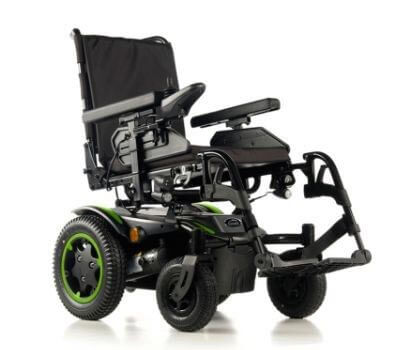
Q200 Sunrise Medical electronic wheelchair with non-expandable electronics
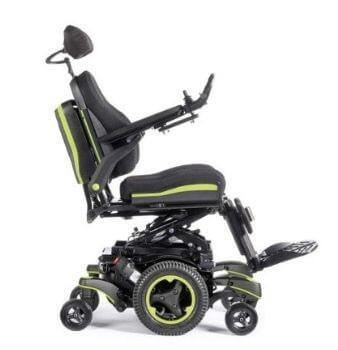
Q700 Sunrise Medical electronic wheelchair with expandable electronics
If the user is unable to operate the joystick, a wheelchair with expandable electronics can be fitted with alternative controls: mini or compact joysticks, head arrays, chin controls, foot controls, Sip 'n Puff, switch controls, scanning controls, etc. Expandable electronics enable the use of smart technology, a real nervous system in which the functions of its various components (motors, automations, controls, etc.) are managed and programmed via data packets processed by artificial intelligence located in a single power module.
Expandable electronics allow to "follow" and adapt the wheelchair to the needs and characteristics of the user, even in the event of rapidly developing progressive diseases. This is an essential aspect to consider when choosing the wheelchair, because there are several models that can be provided with both types of electronics.
Direct Environmental Control
One of the most frequent requests from power wheelchair users is to be able to access environmental controls from the wheelchair, as well as managing mobile ICT (Information Communication Technology) devices such as smartphones and tablets. These devices can concentrate functions and applications that until recently could only be provided by cumbersome ICT equipment, but now they can be easily installed on power wheelchairs with significant benefits on the quality of life of people with diabilities and their caregivers.
Expandable electronics in wheelchairs are therefore offering what was considered not that many years ago as a potential new frontier. The power wheelchair can be equipped with some integrated modules for environmental control, enabling the user to interact with their PC, TV set, as well as lighting, doors, windows, etc. by operating the same controls used to drive the wheelchair.
Environmental control modules are generally integrated in some joysticks (see picture below) or LCD screen modules dedicated to special/alternative controls (see picture below) which allow the user to interact through specific menus with domestic devices that can be operated via IR controls (TV set, decoder, air conditioning unit, etc.).
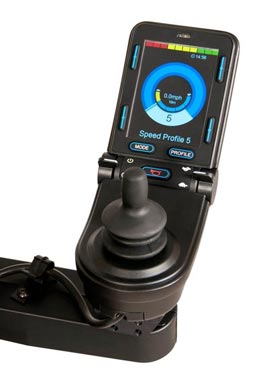
CJSM2 "Advanced" Joystick
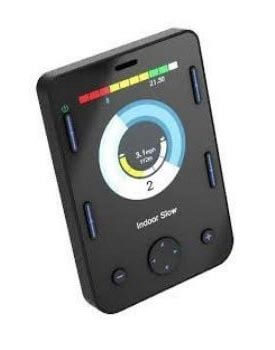
Omni2 LCD screen
The environmental controls integrated module can learn and store the IR codes of every remote control in the house and retransmit them on request. These modules are therefore real programmable universal remote controls16, 17 (see picture below). This interactive mode, which uses the wheelchair's technology to manage the environment, is called direct environmental control.
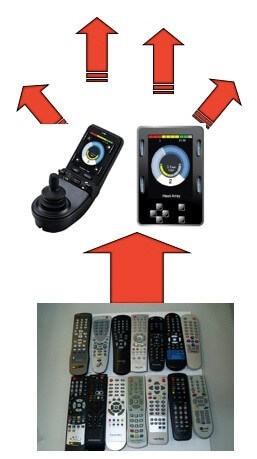
Copying the IR codes of domestic remote controls
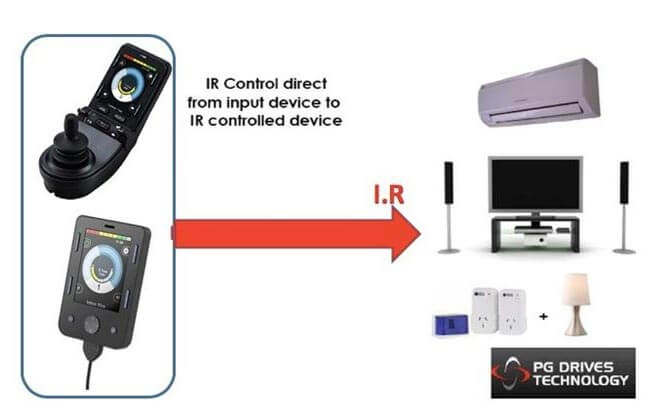
Direct integrated environmental control
Graduated in Occupational Therapy, Physical Therapy, and Sport Science, Devis Trioschi previously worked for 14 years in one of the most known centers for Assistive Technology in Italy, dealing mainly with seating posture and powered mobility devices for adults and children.
Based in Italy, Federico Rizza graduated with a bachelor of Health Sciences (Occupational Therapy) degree from the University of Pavia in 2017. He is the youngest Occupational Therapist that joins this Sunrise Medical Clinical Team, and he is a talented and brilliant clinician despite his young age. He gained experience with a lot of internships in different facilities, being able to see different clinical realities, from spinal units to neurological rehab, working with blind or visually impaired patients always targeting independence in ADLs.
References
- Spagnolin G., Mobilità e postura in carrozzina nella disabilità dell’adulto. Atti del convegno L’ausilio nel progetto riabilitativo della persona disabile. Abano Terme. 2008 Nov 5-7; 30-31
- La Plante MP. Demographics of wheeled mobility device users. Paper presented on Conference on space requirements for wheeled mobility. United States, Buffalo. 2003 Oct 9-11
- Russell JN, Hendershot GE, Le Clere F, Howie LJ, Adler M. Trends and differential use of assistive devices. United States. Advace data from Vital and Health Statistics of the CENTERS FOR DISEASE CONTROL AND PREVENTION/National Center for Health Statistics (292). 1997 13 Nov
- Davies A, De Souza LH, Frank AO. Changes in the quality of life in severely disabled people following provision of powered indoor/outdoor chairs. Disabil Rehabil. 2003 Mar 18; 25(6):286-90
- Buning ME, Angelo JA, Schmeler MR. Occupational performance and the transition to powered mobility: a pilot study. Am J Occup Ther. 2001 May-Jun; 55(3):339-44
- Evans S, Frank AO, Neophytou C, de Souza L. Older adults' use of, and satisfaction with, electric powered indoor/outdoor wheelchairs. Age Ageing. 2007 Jul; 36(4):431-5
- Pettersson I. et al. The value of an outdoor powered wheelchair with regard to the quality of life of persons with stroke: a follow-up study. Ass. Tech. 2007 Fall;19(3):143-53
- Evans R. The effect of electrically powered indoor/outdoor wheelchairs on occupation. A Study of Users' Views. The British Journal of Occupational Therapy .2000 Nov; 63:547-53
- Brandt A, Iwarsson S, Stahle A. Older people's use of powered wheelchairs for activity and participation. J Rehabil Med. 2004 Mar; 36(2):70-7
- Hoenig H, Landerman LR, Shipp KM et al. A clinical Trial of a rehabilitation expert clinician versus usual care for providing manual wheelchairs. J Am Geriatr Soc. 2005 Oct; 53(10):1712-20
- Cook A, Hussey S. Technologies that enable mobility. In: Cook A, Hussey S. Assistive Technologies principles and practice. Mosby Elsevier, St. Louis – Missuri, 2002; 360
- De Tanti A, Saviola D, Fochi F. Use and prescription of powered electronic wheelchairs for patient with severe acquired brain injury. In Assistive Technology from Adapted Equipment to Inclusive Environments. AAATE 2009. Amsterdam: IOS Press, 2009; 440-5
- Ganesh S, Hayter A, Kim J et al. Wheelchair use by veterans newly prescribed a manual wheelchair. Arch Phys Med Rehabil. 2007 Apr; 88 (4):434-9
- Mortenson WB, Miller WC. The Wheelchair Procurement Process: Perspectives of Clients and Prescribers. Can J Occup Ther. 2008 Jun; 75(3):167–175
- Mortenson WB, Miller WC, Mille-Pogar J. Measuring wheelchair intervention outcomes: development of the wheelchair outcome measure. Disability & Rehabilitation: Assistive Technology, 2007; 2:275-85
- Trioschi, D., (2015). Carrozzina elettronica: controllo ambientale e accesso ai dispositivi informatici. Il Fisioterapista, edi-ermes, nov-dic 2015; 6:71-75
- Trioschi D. Una casa su misura: domande e risposte per migliorare l'accessibilità domestica. Bologna: Centro Ausili - Regione Emilia Romagna, 2007; 53-62 (unacasasumisura.it)